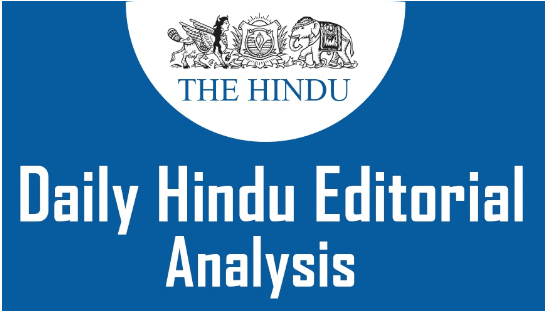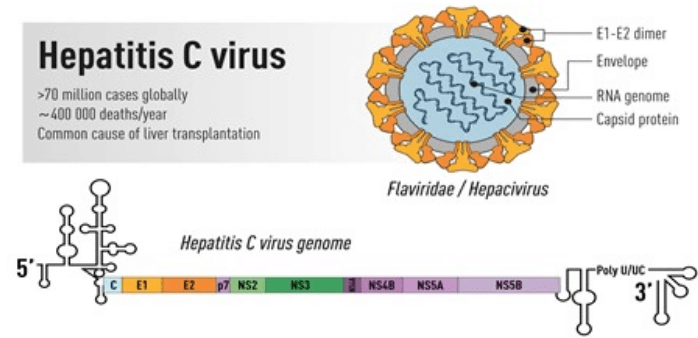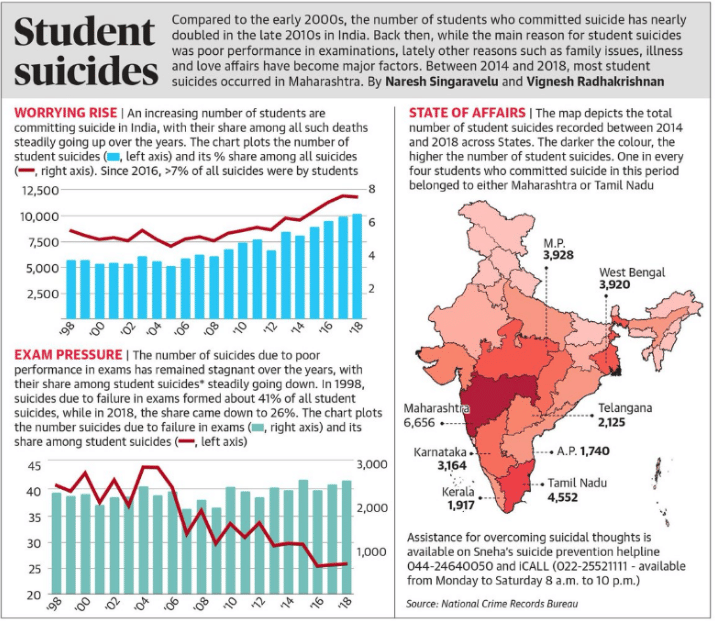The Hindu Editorial Analysis- 7th October, 2020 | Additional Study Material for UPSC PDF Download

1. VANQUISHING VIRUSES: ON NOBEL PRIZE FOR MEDICINE-
GS 3- Science and Technology- developments and their applications and effects in everyday life
Context
(i) Nobel Committee decided to anoint(choose) three scientists who peeled the layers (solved problem) off another virus that confounded(irritated) generations of physicians — the Hepatitis C virus (HCV).
(ii) The 2020 Nobel Prize in Physiology or Medicine, to Harvey J. Alter, Michael Houghton and Charles M. Rice, is a stout endorsement of years of work that went towards identifying one of the world’s greatest scourges(suffering).
(iii) But to see it shorn(cut) of the context it is couched in would be to miss the larger point or purpose it could serve.
(iv) Choosing researchers who went after a pathogen, and succeeded in unwrapping the whole puzzle at a time when others are fighting fatigue(tiredness) in a daily battle against the SARS-CoV-2 virus, is also a hat tip(recognition) to the virologists and geneticists burning the midnight oil(working hard), for over nine months now.

Discovery Of Hcv
(i) The accolades(praises) went to the three for identifying the viral origin of Hepatitis C.
(ii) Their work, the Nobel statement said, characterised this form of hepatitis to be a distinct clinical entity, caused by an RNA virus of the Flavivirus family, now known as HCV.
(iii) In fact, it was for the discovery of the Hepatitis B virus (HBV), and the development of the first-generation HBV vaccine, that Baruch Blumberg, whom the young Alter collaborated with, was awarded the 1976 Medicine Nobel.
(iv) However, even the isolation of the HBV only partially eliminated the risk of contracting this severe liver disease transmitted through blood. The circle was only complete with the discovery of HCV.
(v) According to the WHO Global Hepatitis report, HBV and HCV are major causes for mortality and morbidity, with 1.34 million deaths reported in 2015, a 63% increase from 1990, mainly due to HCV.
(vi) The number of deaths is also comparable to that caused by TB and higher than that caused by AIDS.
(vii) The discoveries (of HBV and HCV), and the development of effective screening routines, have virtually eliminated(end) the risk of transmission via blood products in much of the world.
(viii) Also, with the development of effective drugs against HCV, it is possible that the threat of this viral infection will reduce, and hopefully, be eliminated soon.
(ix) That is what makes this year’s Laureates’ achievement so tremendous.
(x) The Nobel Committee called it “among the most impactful scientific accomplishments of the 20th century”.
(xi) In true lineage of other Nobel Prizes for Medicine, their identification represents “milestone achievements that have revolutionised medicine and substantially improved human health”.
Conclusion
(i) The triumph(win) of humanity over the pathogens that debilitate(harm) and kill men and women is certainly a singular achievement that is worth celebrating.
(ii) Showcasing this achievement will send a deeply inspiring message at a time when another virus is holding the world to ransom(disorder).
(iii) The Nobel Prize for Medicine is an inspiration to researchers working on SARS-CoV-2.
2. A WAKE-UP CALL FOR THE REPUBLIC-
GS 2- Important aspects of governance, transparency and accountability
Context
(i) No social contract can eliminate(end) crime in society. History has shown constant hostility(aggression) between criminals who disturb the social order and those who endeavour(strive) to maintain it.
(ii) Laws dealing with crimes and criminals emanate(come) from power structures, in one form or another, charged with the responsibility of maintaining the social order.
(iii) Social order allows individuals to go about their everyday lives in the belief that they enjoy the protective cover of those wielding authority.
(iv) No modern society should tolerate individual rights to be trampled(hit) upon and individual liberties to be sacrificed by the state and its machinery collaborating with or aiding those charged with offences that disturb societal peace and tranquility.
(v) Of late, our Republic has witnessed crimes, the sheer barbarity(horrible) of which has shocked our collective conscience.
(vi) Perpetrators of such heinous crimes have been emboldened(raised in confidence) by the manner in which the state investigating machinery has been dealing with them in the recent past.

The Colours Of Violence
(i) Since 2014, caste-based criminal targeting has increased exponentially. Dalits are often victims of upper-caste brutality(violence).
(ii) The iniquitous caste structure accompanied by unforgiving mindsets allows such crimes to be committed with impunity(protection).
(iii) The perpetrators believe that the state machinery will come to their aid because of caste affiliations(support) embedded in the power structure.
(iv) This explains the public lynching(hitting) of Dalits and the forgotten episodes of their victimisation including sexual assault, with perpetrators going unpunished.
(v) Caste and poverty go hand in hand. Those at the bottom of the caste structure are also immersed in poverty. They lack the wherewithal to get justice.
(vi) Then there are crimes based on religious predilections(likings).
(vii) Minorities within a majoritarian state need the protective measure of the state because the prevalent majoritarian culture seeks dominance which often expresses itself in violent retributions.
(viii) Innocent victims are attacked for not following majoritarian diktats(order).
(ix) They are targeted for what they wear and for their physical attributes. They are publicly shamed and made to pay for the perceived sins of their ancestors.
(x) The perpetrator is perceived to represent majoritarian nationalist sentiment.
(xi) The third aspect is the foisting of an ideology on those who either don’t subscribe to it or are openly opposed to it. Here, the politics of violence takes over.
(xii) The political class, in suppressing the voice of dissent, seeks to use violence as a weapon to instil fear so that the message of conformity percolates(enters) downstream to quell(end) all forms of opposition.
(xiii) The Indian state, therefore, has to confront violence which has cultural, religious and political colour.
State Of The Legal System-
(i) For the rule of law to prevail, the legal system must equip itself to meet the expectations of the law. It must investigate fairly, remain unbiased, and punish the guilty.
(ii) But the legal system seems to have distanced itself from the law by doing the bidding of dominant affiliations.
(iii) Recent tragedies fuel doubts about the nature of the state and the role of investigating agencies.
(iv) How then does one explain a crime recognised by a Constitution Bench of the Supreme Court to have been committed in public gaze culminating in the court unable to identify both the conspiracy and the conspirators?
(v) How does one explain the conduct of an investigating agency which cremates a 19-year-old victim in secrecy at 2:30 in the morning without informing the family?
(vi) How do we come to terms with the opinion of that agency that the victim was not raped despite the family referring to the condition of the girl and later her dying declaration alleging gang-rape?
(vii) The cases relating to lynching of Mohammad Akhlaq and the rape victim in Kathua along with the politics of dominance surrounding such crimes show the state machinery as biased and unforgiving not qua the perpetrators but qua the victims.
(viii) Any investigating agency has the ability to botch an investigation: manipulate records, fail to record statements of key witnesses, wilfully choose not to collect evidence crucial to the case, and ensure that witnesses incriminating(holding guilty) the accused are not produced in court.
(ix) The court finds itself helpless and occasionally chooses not to help itself and the law.
(x) When the nexus(link) among the state, investigating agencies and the accused becomes the norm, the victim is the rule of law.
Conclusion
(i) It is a wake-up call for the Republic. Some of our spineless institutions with their open biases have led to this abysmal(poor) state of affairs.
(ii) The only institution that can withstand such aberrations that make the citizen lose faith in the functioning of the state is the court.
(iii) Our future will depend on the court’s courage to call a spade a spade.
3. THE DISINTEGRATION OF THE CRIMINAL JUSTICE SYSTEM-
GS 2- Important aspects of governance, transparency and accountability
Context
(i) A well-established textbook on the principles of criminal law in the United Kingdom painstakingly establishes various theoretical bases for justifying what should be a crime — that it should involve some harm, must carry a certain degree of seriousness, and so on.
(ii) But then, revealingly, it undoes this edifice in a single section by telling us that at the end of the day, criminal law and crimes are whatever the state says it is.
(iii) In India, this political nexus is arguably more pronounced.
(iv) A majority government makes the laws and controls the investigative machinery, which means that not only does it define what a crime is but it can also selectively pursue only those crimes which it cares about and forget about the rest.
In Disarray Across India-
(i) Pursue those crimes to what end, you ask. Ultimately, the idea of “crime” is hollow without the accompanying punishment.
(ii) The loss of liberty upon imprisonment we are all taught to dread. However, it is often forgotten that this punishment can only arise upon a judgment of conviction at the end of a trial.
(iii) There is, then, a synergy between the crime, its pursuit by an investigation, and the calling to account of those found guilty, which is colloquially(informally) referred to as a criminal justice system.
(iv) The morbid(unhealthy) happenings in the State of Uttar Pradesh are but one stark example of just how bad things can get.
(v) A notorious gangster was involved in a gunfight with police, fled, and was later captured from another State.
(vi) In the meanwhile, the news was awash with stories alleging(blaming) corrupt links of the accused to public servants.
(vii) As his entourage made its way back to Uttar Pradesh, there was an “encounter” and the accused was shot dead.
(viii) There was a crime, several crimes in fact. The State police decided to pursue it. However, there was no waiting for a trial to condemn the accused and sentence him; punishment was swiftly meted out by the police itself.
(ix) So much so, that an erstwhile Supreme Court Judge felt that the State’s version of events made it appear as if it did not even care whether the encounter story was believed or not.
Extremes In Uttar Pradesh-
(i) If the Vikas Dubey encounter death demonstrated a willingness to punish without condemning an accused through trial, Uttar Pradesh has also demonstrated a willingness to condemn without any trial.
(ii) It passed a law enabling the publishing of massive hoardings with the names and personal details of persons allegedly involved in the destruction of property caused in riots following the anti-Citizenship Act protests.
(iii) But, here is the thing: all of this is before a court convicted them for these acts.
(iv) Rather, the power to condemn was sourced not from a judicial order, but from the power to level allegations, which is wholly executive in scope.
(v) In this fashion, the police became judge, jury, and executioner.
(vi) Of course, these instances are where the State decided to pursue alleged crime.
(vii) There are many cases where it turns a blind eye(ignores) to incidents of violence, either indefinitely or for long enough.
(viii) A young girl was brutally assaulted and left to die when she was found by her family on September 14 in the village of Hathras, Uttar Pradesh.
(ix) The same family did what anyone would do — report the incident to the police while they rushed their daughter to a hospital.
(x) Only, here, despite the injuries being evident, the police did not register a case for hours, and even then did not include the serious offence of rape.
(xi) Of course, where the police was not willing to register this single case of rape, it has swiftly registered at least 19 cases regarding an alleged conspiracy to use the incident for political purposes to show the State in a bad light.
Govt.-Judiciary Disconnect-
(i) There are clear, discernible(visible) tendencies which these examples from the State of Uttar Pradesh only serve to demonstrate.
(ii) These are, first, the growing disconnect between the government and judiciary in matters of criminal justice;
(iii) Second, the bolstering(increasing) of executive power as a result of this growing disconnect, and;
(iv) Third, the unsurprising(predictable) imitation of executive-mindedness by the judiciary.
(v) The result of this is a transformation from a criminal justice system, to a problem-solving system.
(vi) The Crime in India data for 2019 confirm a trend that has been on display for decades now: our police are seemingly super-efficient, but our courts are super-slow. Let us continue with Uttar Pradesh as an example.
(vii) Its police have a pendency rate for cases at just above 15%, but the courts have pendency rates just above 90% (for IPC crimes).
(viii) And, worryingly, these are not the worst figures. What this means is that as police forces keep adding to the docket every year, the courts are becoming ever slower in their ability to conduct trials and pass judgments.
Filling The Gap
(i) This exacerbates(worsens) the natural time-gap between the incident and any potential punishment, and reduces the importance of courts in the criminal justice system.
(ii) Among other things, this disconnect also reduces whatever value condemnation through trial might have had, as people move on and so does life in almost all cases.
(iii) Just how severely this tendency is magnified in an era defined by the 24-hour news cycle is anyone’s guess.
(iv) How does a system fill this gap between incident and eventual judgment?
(v) By slowly legitimising the idea of punishments without condemnation or any kind of being called into account. All that matters, is solving the problem, and moving on.
(vi) This system where judges lose sway is where the executive gains more power.
(vii) It is the arrest, and not a conviction, which becomes the seminal moment in the criminal process.
(viii) Victims do not even think as far as proving anything in court, at times, and all that matters is arrest and an indefinite incarceration, or even an encounter if the allegation is heinous enough.
(ix) At the same time, the executive tries to legally bolster powers of pre-trial arrest and custody, while also arrogating to itself more powers to punish without condemnation — asset forfeiture(capture) being a key power.
Presumption Of Innocence-
(i) The transformation stands complete, when judges try to regain some of their lost footing by trying to imitate the now popular branch.
(ii) Courts become happy to look at facts, in detail, at the stage of bail itself.
(iii) What is more, courts also become willing to help arrive at settlements through this stage by using incarceration as a bargaining tool to force errant accused persons to make reparations.
(v) In doing so, courts actively replace facts established through cross-examination of a witness with her untested allegations that the police decided to pursue, because even courts no longer have the time for the process either.
(vi) The presumption of innocence be damned, so long as the problem is solved and a victim can go home satisfied.
(vii) Amidst this pandemic and the spiralling chaos that it has brought, there has been a comforting background score that has steadily played on.
Conclusion
(i) This is the systematic disintegration of any criminal justice system worth its name across India, and its gradual replacement with a problem-solving system where initial accusations and their handling by the executive branch becomes most critical and values such as the presumption of innocence and establishing truth through trials have long ceased(ended) to exist.
(ii) That certain States are at the vanguard(protector) of this progression could, perhaps, cynically be seen as yet another symptom of their development which makes many others envious.
|
21 videos|562 docs|160 tests
|
FAQs on The Hindu Editorial Analysis- 7th October, 2020 - Additional Study Material for UPSC
| 1. What is the significance of The Hindu Editorial Analysis for UPSC exam preparation? |  |
| 2. How can The Hindu Editorial Analysis help in improving one's writing skills for the UPSC exam? |  |
| 3. Is it necessary to read The Hindu newspaper along with The Hindu Editorial Analysis for UPSC exam preparation? |  |
| 4. How can The Hindu Editorial Analysis help in improving one's vocabulary for the UPSC exam? |  |
| 5. Can The Hindu Editorial Analysis be a substitute for reading other newspapers for UPSC exam preparation? |  |
















